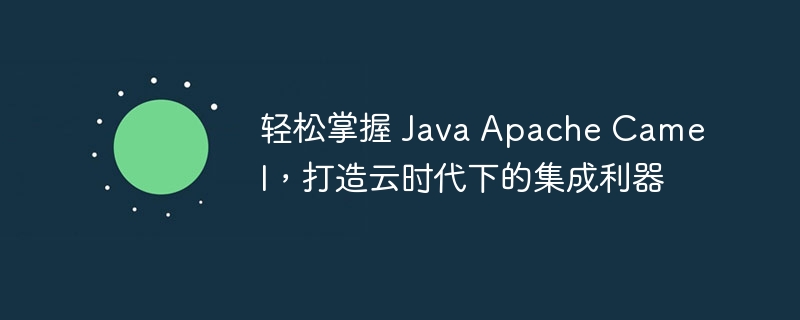Home >Java >javaTutorial >Easily master Java Apache Camel to create an integrated tool in the cloud era
Easily master Java Apache Camel to create an integrated tool in the cloud era
- 王林forward
- 2024-02-20 11:20:08705browse

php editor Banana has published an excellent article on how to easily master Java Apache Camel and use it to create an integrated tool in the cloud era. The article covers detailed usage methods and techniques to help readers quickly master relevant knowledge and better apply it to actual project development. Through this article, readers can gain an in-depth understanding of how to leverage Java Apache Camel for efficient integration and stand out in the cloud era.
1. Key features of Apache Camel
Apache Camel provides the following key features:
- Routing Engine: Camel provides a powerful routing engine that can easily route messages from one endpoint to another.
- Multiple transmission protocols: Camel supports multiple transmission protocols, including Http, JMS, AMQP, FTP, SFTP, Emai l etc.
- Data format conversion: Camel can easily convert data in different formats, including XML, JSON, CSV, EDI, etc.
- Rich data operations: Camel provides rich data operation functions, including filtering, sorting, aggregation, segmentation, etc.
- Powerful error handling mechanism: Camel provides a powerful error handling mechanism that can help developers easily handle various errors during the integration process.
2. Apache Camel use case demonstration
Below we show how to use Apache Camel through a simple use case demonstration.
Suppose we have an application that needs to read a file from a file system and send its contents to a JMS queue. We can use the following code to achieve this integration:
import org.apache.camel.CamelContext;
import org.apache.camel.builder.RouteBuilder;
import org.apache.camel.impl.DefaultCamelContext;
public class FileToJmsDemo {
public static void main(String[] args) throws Exception {
// 创建 Camel 上下文
CamelContext camelContext = new DefaultCamelContext();
// 定义路由
camelContext.addRoutes(new RouteBuilder() {
@Override
public void configure() throws Exception {
// 从文件系统读取文件
from("file:input?noop=true")
// 将文件内容转换为字符串
.convertBodyTo(String.class)
// 将字符串发送到 JMS 队列
.to("jms:queue:output");
}
});
// 启动 Camel 上下文
camelContext.start();
// 等待一段时间,让集成过程完成
Thread.sleep(5000);
// 停止 Camel 上下文
camelContext.stop();
}
}
This code first creates a Camel context and then defines a route. The route reads a file from the file system, converts the file contents into a string, and sends the string to a JMS queue. Finally, start the Camel context, wait for a while, and then stop the Camel context.
3. Advantages of Apache Camel
Apache Camel has the following advantages compared to other integration frameworks:
- Easy to use: Apache Camel provides a simple and easy-to-use API, making it easier to create complex integration solutions.
- Strong flexibility: Apache Camel supports a variety of programming languages, transport protocols, and data formats, making it easy to integrate different applications, systems, and services.
- Strong scalability: Apache Camel provides a powerful extension mechanism that allows developers to easily extend Camel's functionality.
4. Limitations of Apache Camel
Apache Camel also has certain limitations, including:
- Steep learning curve: Apache Camel has rich features and options, and the learning curve is relatively steep.
- High performance overhead: Compared with other lightweight integration frameworks, Apache Camel has a relatively large performance overhead.
5. Summary
Apache Camel is a powerful enterprise integration framework that helps developers easily integrate disparate applications, systems, and services. Apache Camel is easy to use, flexible and scalable, but has a steep learning curve and high performance overhead.
The above is the detailed content of Easily master Java Apache Camel to create an integrated tool in the cloud era. For more information, please follow other related articles on the PHP Chinese website!
Related articles
See more- Laravel integration Swoole tutorial
- What technology is the development and application of cloud computing?
- Technology Forecast for 2023: Development Trends of Artificial Intelligence, Cloud Computing, Edge Computing, and Network Security
- What are the five major characteristics of cloud computing?
- How to quickly integrate jsmind mind map plug-in in Vue project?

